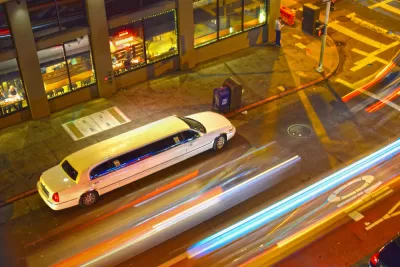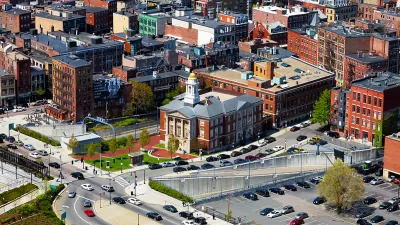Only a handful of cities in North America are considering applying tolls to congested urban streets, as opposed to highways. Efforts in one of those cities, San Francisco, just received negative polling results on a potential $3 auto access fee.

Urban or cordon tolling has proven to be effective in large cities in Europe and Asia, but has yet to gain a toehold in North America, though some major cities, such as Vancouver, Seattle, Los Angeles, New York and San Francisco, are considering it.
Joe Fitzgerald Rodriguez, who covers transportation for the San Francisco Examiner, reports that "support for congestion pricing downtown among San Franciscans is nearly as low as it can get, according to a city poll released Tuesday."
The Dignity Healthy CityBeat poll [pdf] from the San Francisco Chamber of Commerce revealed only 16 percent of San Franciscans strongly support charging a $3 fee to people driving in and out of downtown during commute hours.
On the flipside, 51 percent of respondents strongly oppose the plan, with 14 percent “somewhat” opposing the plan, and 14 percent “somewhat” supporting the plan. All told, that’s 30 percent of San Franciscans backing the idea, and 65 percent rejecting it.
However, congestion pricing advocates should not be discouraged. The results are a tad better than those reported by The Seattle Times Traffic Lab last month on a similar type of cordon toll plan, which found that only 26 percent of city residents supported a downtown access charge for motor vehicles. The proposal, included in the April 2018 Seattle Climate Action plan [pdf] unveiled last April by Mayor Jenny Durkan, is one of many strategies used to meet a 2011 goal of having the city achieve carbon neutrality by 2050. See page 14:
Improving mobility through pricing:Announce that the City will develop and release a strategy to address congestion and transportation emissions through pricing, coupled with investments in expanded transit and electrification in underserved communities.
Notwithstanding the lackluster support for cordon tolling, "the Board of Supervisors, acting in their capacity as the San Francisco County Transportation Authority board [on Tuesday], authorized $500,000 to further study the concept in San Francisco," notes Rodriguez. The budget request for the Downtown Congestion Pricing Study begins on pg. 57 of 71 in the Transportation Authority's Prop K/Prop AA Allocation Request Form [pdf].
Referencing low support in the CityBeat poll, Supervisor Rafael Mandelman said instituting the scheme would be “a heavy lift.”
“I think there is inherent concern and doubt about this approach,” he said, while acknowledging it is “one of the few tools we have left” to combat downtown traffic congestion is congestion pricing.
Tilly Chang, executive director of the Transportation Authority, tweeted that "the [San Francisco] chamber has asked this question every year since we at @sfcta first studied congestion charges in 2010, however, their poll question leaves out mention of the many significant benefits (reduced congestion, improved transit, safer streets and lower emissions)."
Indeed, a review of Planetizen's congestion pricing archives finds "The Case Against San Francisco's Congestion Pricing Plan," December 24, 2008:
In this San Francisco Chronicle op-ed, "San Francisco is not London", Steve Falk, the CEO of the S.F. Chamber of Commerce, explains why London-style congestion pricing is inappropriate for the downtown core - that it would only hurt businesses without reducing congestion.
A decade later, the group remains convinced that a downtown access toll would be bad for business, a far cry from the position of the Partnership for New York City, which represents that city’s business leadership. On Feb. 7, the group announced support for cordon pricing "to fund modernization of the subway, bus and commuter rail system and to ensure that New York remains a thriving global city,” said Kathryn Wylde, President & CEO.
As for the funding source for the study, the Transportation Authority's Prop K webpage states that it is "a half-cent local sales tax for transportation that was approved by San Francisco voters in November 2003 that is used to fund everything from signals to streetcars, bicycles to boulevards, and pedestrian safety improvements to paving."
Hat tip to The Bay Link.
FULL STORY: Polling show SF residents reject congestion pricing proposal

Planetizen Federal Action Tracker
A weekly monitor of how Trump’s orders and actions are impacting planners and planning in America.

Congressman Proposes Bill to Rename DC Metro “Trump Train”
The Make Autorail Great Again Act would withhold federal funding to the system until the Washington Metropolitan Area Transit Authority (WMATA), rebrands as the Washington Metropolitan Authority for Greater Access (WMAGA).

The Simple Legislative Tool Transforming Vacant Downtowns
In California, Michigan and Georgia, an easy win is bringing dollars — and delight — back to city centers.

The States Losing Rural Delivery Rooms at an Alarming Pace
In some states, as few as 9% of rural hospitals still deliver babies. As a result, rising pre-term births, no adequate pre-term care and "harrowing" close calls are a growing reality.

The Small South Asian Republic Going all in on EVs
Thanks to one simple policy change less than five years ago, 65% of new cars in this Himalayan country are now electric.

DC Backpedals on Bike Lane Protection, Swaps Barriers for Paint
Citing aesthetic concerns, the city is removing the concrete barriers and flexposts that once separated Arizona Avenue cyclists from motor vehicles.
Urban Design for Planners 1: Software Tools
This six-course series explores essential urban design concepts using open source software and equips planners with the tools they need to participate fully in the urban design process.
Planning for Universal Design
Learn the tools for implementing Universal Design in planning regulations.
Smith Gee Studio
City of Charlotte
City of Camden Redevelopment Agency
City of Astoria
Transportation Research & Education Center (TREC) at Portland State University
US High Speed Rail Association
City of Camden Redevelopment Agency
Municipality of Princeton (NJ)





























